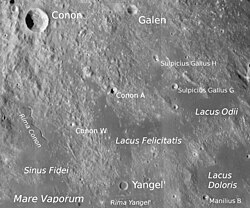幸福湖
| 幸福湖 | |
|---|---|
 | |
| 坐標 | 18°30′N 5°24′E / 18.5°N 5.4°E |
| 直徑 | 90 公里 |
| 命名來源 | 幸福湖 |



幸福湖又譯為菲里斯塔迪斯湖(拉丁語:Lacus Felicitatis),位於月球正面澄海、汽海和雨海間三角狀的雪陸內。這裡是一小片已被熔岩流淹沒、且反照率較周邊地形更低的平坦區,尺寸約100公里。該湖名首次出現於1974年發表的美國軍事測繪局為美國宇航局繪製的月圖上[1],1976年被國際天文學聯合會批准採納[2][3]。
位置和附近特徵
[編輯]幸福湖的中心點月面坐標為北緯18.5°、東經5.4°[2],東北與怨恨湖接壤、東南毗鄰憂傷湖、南面是汽海、西側是忠誠灣。幸福湖東北70-80公里處是綿延的海瑪斯山脈(一道環澄海盆地的山脊),西北100公里則是亞平寧山脈(類似的環雨海盆地山脊),幸福湖南面是位於汽海邊緣直徑8公里的揚格利隕石坑,幸福湖東北岸附近是直徑6公里的衛星坑"科農 A"[4]。
描述
[編輯]幸福湖的形狀像一支二端分別指向西北和東面的迴旋鏢,東西約100公里,西北長140公里,終點處不太清晰。湖表高度低於月表基準0.3-1.1公里。
它是位於直徑50公里,已被熔岩填塞且嚴重損毀的衛星坑"曼尼里烏斯 E"東面的三座月湖之一。月湖中央從北至南延伸着一條30公里寬、200-600米高[5][6] [7]的細長高原(地壘), 該高原上坐落着一座300米高,直徑17公里的月丘,可能是一座古老火山[6],其頂部地貌外觀極為異常且起源神秘,錯落分布着寬3×2公里、深約30米的溝槽及變形蟲般的低矮山丘,它被命名為艾娜月坑[6][8],是月球上數十個此類特徵中最大的一座,類似於水星上已知的凹陷地貌[9]。與艾娜一起被命名的還有它左側的二座隕坑(奧薩馬和達格)以及它裡面的一座山丘(阿格妮絲山)[10],這是截止2015年該月湖中所有已命名的特徵項目[7]。
該區域內有三座小型隕石坑已經被國際天文學聯合會命名,詳見下表:
| 隕石坑 | 月面坐標 | 直徑 | 名稱來源 |
|---|---|---|---|
| 達格 | 18.7° N, 5.3° E | 0.5 公里 | 斯堪的納維亞男性名 |
| 艾娜 | 18.6° N, 5.3° E | 3 公里 | 拉丁文女性名 |
| 奧薩馬 | 18.6° N, 5.2° E | 0.5 公里 | 阿拉伯男性名 |
艾娜月坑是一座只有30米深的半圓形凹坑,從地球上很難看見它,2006年11月,它被認為是在過去1000萬年間氣體噴發的結果。[11][12]
參考資料
[編輯]- ^ NASA Lunar Topographic Orthophotomap (based on Apollo 15 and 17 photos). Scale 1:250,000. Sheet LTO-41C4: Yangel' ed. 2. Prepared and published by the Defence Mapping Agency Topographic Center, Washington, D.C. October 1974 [2016-04-18]. (原始內容存檔於2016-03-06).
- ^ 2.0 2.1 Lacus Felicitatis. Gazetteer of Planetary Nomenclature. International Astronomical Union (IAU) Working Group for Planetary System Nomenclature (WGPSN). [2014-11-20]. (原始內容存檔於2014-11-20).
- ^ E. Müller & A. Jappel. Transactions of the IAU: volume XVIB (Proceedings of the 16th General Assembly of the IAU). D. Reidel Publishing Company. 1977: 341. ISBN 90-277-0836-3. (原始內容存檔於2016-08-30).
- ^ According to the laser altimeter on the satellite Lunar Reconnaissance Orbiter, obtained through the program JMARS (頁面存檔備份,存於網際網路檔案館)
- ^ Strain, P. L.; El-Baz, F. The geology and morphology of Ina. Proceedings of 11th Lunar and Planetary Science Conference, Houston, TX, March 17-21, 1980. 1980, 3: 2437–2446. Bibcode:1980LPSC...11.2437S.
- ^ 6.0 6.1 6.2 Garry, W. B.; Robinson, M. S.; Zimbelman, J. R.; Bleacher, J. E.; Hawke, B. R.; Crumpler, L. S.; Braden, S. E.; Sato, H. The origin of Ina: Evidence for inflated lava flows on the Moon (PDF). Journal of Geophysical Research. 2012年11月, 117: E00H31. Bibcode:2012JGRE..117.0H31G. doi:10.1029/2011JE003981. (原始內容 (PDF)存檔於2014-11-04). (міні-версія (頁面存檔備份,存於網際網路檔案館), Bibcode:2011LPI....42.2605G, Map)
- ^ 7.0 7.1 Наведено за Directory МАС (頁面存檔備份,存於網際網路檔案館)
- ^ Chan, N. W.; Vaughan, W. M.; Head, J. W. Lunar Ina-Like Features: Maps and Morphometry (PDF). 45th Lunar and Planetary Science Conference, held 17-21 March, 2014 at The Woodlands, Texas. LPI Contribution No. 1777, p.1001. 2014年3月 [2016-04-18]. Bibcode:2014LPI....45.1001C. (原始內容存檔 (PDF)於2016-03-03).(poster)
- ^ Stooke, P. J. Lunar Meniscus Hollows (PDF). 43rd Lunar and Planetary Science Conference, held March 19-23, 2012 at The Woodlands, Texas. LPI Contribution No. 1659, id.1011. 2012年3月 [2016-04-18]. Bibcode:2012LPI....43.1011S. (原始內容 (PDF)存檔於2016-03-04).
- ^ NASA lunar topophotomap (based on Apollo 15 photos). Scale 1:10,000. Sheet 41C3S1(10) Ina ed. 1. Prepared and published by the Defence Mapping Agency Topographic Center, Washington, D.C. 1974 [2016-04-18]. (原始內容存檔於2016-04-08).
- ^ 月亮仍然还跃吗?. NASA. 2006年11月9日 [2007-07-30]. (原始內容存檔於2006年11月10日).
- ^ Schultz, Peter H., Matthew I. Staid & Carlé M. Pieters, Lunar activity from recent gas release, Nature 444, 184-186 (9 November 2006) doi:10.1038/nature05303 Bibcode:2006Natur.444..184S Abstract (頁面存檔備份,存於網際網路檔案館)

